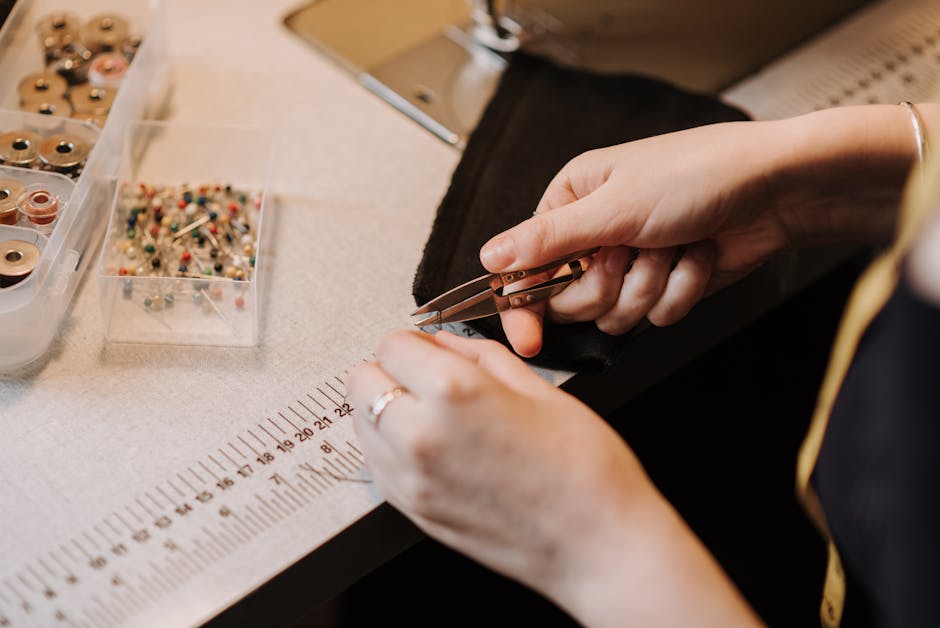Introduction to Sewing Supplies for Creative Textiles
Starting a sewing project is thrilling, but knowing what tools you’ll need is essential. At the heart of any textile masterpiece are basic sewing supplies that serve as the foundation for creativity. You don’t need to break the bank or fill your space with fancy gadgets to get started. Focus on gathering quality essentials. First, a sturdy pair of scissors is non-negotiable for cutting fabric with precision. Avoid using them on anything else to keep them sharp. Next, a variety of needles – hand sewing and machine needles – are crucial. They come in different sizes for a reason; usage depends on the fabric’s thickness. Thread is another obvious must-have, with a rainbow of colors at your disposal, but start with neutrals like black, white, and grey. A durable, easy-to-read measuring tape will save you from countless headaches, ensuring your projects measure up perfectly. Don’t overlook the importance of straight pins and a pin cushion; they’re lifesavers for holding fabric in place. And a seam ripper—trust me, mistakes happen to everyone, and this little tool is a miracle worker for undoing them. A good, clear ruler and a fabric marker or chalk will assist in making accurate marks and cuts. Lastly, investing in a quality iron and ironing board is crucial for giving your projects a professional look. With these supplies, you’ll be well on your way to creating textile projects that stand out. Remember, the right tools can make all the difference between a project that’s a struggle and one that’s a joy.
Essential Sewing Supplies: The Basics for Getting Started
Before diving into any innovative textile project, make sure you’ve got the basics covered. Every crafter needs the right tools to bring their vision to life. First up, everyone needs a reliable sewing machine that suits their project needs and skill level. Don’t forget to stock up on various sewing needles – they’ll come in handy for different fabric types. Thread in an assortment of colors is a no-brainer. You’ll also want a sturdy pair of scissors, specifically designed for cutting fabric; these will make your cutting tasks a lot smoother and more precise. A seam ripper is essential for those inevitable mistakes. Let’s be real, mistakes happen to the best of us, and a good seam ripper can save you a lot of frustration. Measuring tools like a soft tape measure and a ruler are crucial for ensuring your projects measure up, quite literally. Pins and a pincushion will keep everything in place as you work, and marking tools will allow you to make temporary marks on your fabric for cutting or sewing guides. Lastly, an iron and ironing board are must-haves for pressing out those wrinkles and giving your project a professional finish. With these supplies at your side, you’re well on your way to tackling those innovative textile projects.
Advanced Sewing Tools for Innovative Projects
When aiming to bring innovation to your textile work, stepping up your toolkit is a game changer. Beyond your basic needles and thread, there exist advanced sewing tools designed to push the boundaries of your projects. Rotary cutters offer precision and speed, slicing through fabric with ease, a must-have for clean, straight edges. Self-healing cutting mats protect your surfaces and extend the life of your rotary blades, proving to be a dynamic duo when cutting. A seam ripper with a fine tip lets you correct mistakes without frustration, ensuring your projects remain flawless. Adjustable dress forms can revolutionize how you approach garment making, allowing for custom fittings and adjustments without a model. For those intricate details and to avoid hand fatigue, ergonomic sewing scissors are essential; they’re designed for comfort and precise cutting over long periods. Digital fabric printing technology opens up a new world of customization, enabling you to create unique fabric designs that set your work apart. Don’t overlook the power of quality ironing equipment; a steam iron with various heat settings and a pressing cloth can be the difference between homemade and professional-looking finishes. With these advanced tools in your arsenal, you’re not just sewing; you’re crafting pieces that stand out, combining skill with innovation to push the boundaries of textile art.
The Best Fabrics for Your Textile Creations
Choosing the right fabric is crucial when you’re diving into textile projects. Cotton, being versatile and easy to handle, is a solid starting point for beginners and experienced crafters alike. It’s great for quilting and everyday wear items. If you’re aiming for more flowy and elegant pieces, silk is your go-to. But remember, it’s a bit trickier to work with, so maybe get some practice in before tackling a big project. For those cozy, comfortable creations like blankets or casual wear, fleece is a warm option, especially in cooler weather. Denim is durable and perfect for items that need to withstand a lot of wear and tear, think bags or jackets. Lastly, if you’re into making sportswear or swimwear, stretchy materials like spandex are essential. They add flexibility and comfort to garments meant to move with you. Each fabric has its unique qualities and will affect the final look and feel of your project, so choose wisely based on what you’re aiming to make.
Measuring and Cutting Tools: Precision in Textile Art
Measuring and cutting tools are your bread and butter in the crafting universe of textiles. They’re not just tools; they’re your best buddies on the path to precision. Let’s break it down. First off, you’ve got your tape measure. This isn’t just any tape measure. It’s flexible, it’s reliable, and it comes in inches and centimeters. It’s essential for getting those cloth measurements right. Next, there’s the tailor’s chalk. It’s like the magic marker of the sewing world, but better because it washes off. It lets you mark where to cut or sew without leaving a permanent reminder of any mistakes.
Now, onto the cutting. Scissors are obvious, right? But not just any scissors. You need fabric scissors that are sharp and comfy in your hand. They slice through fabric like butter, making your cutting tasks a breeze. Then, for the more intricate work, there’s the rotary cutter. It rolls smoothly, cuts neatly, and is perfect for curves and straight lines alike. But remember, a rotary cutter is only as good as its cutting mat. The mat protects your surfaces and keeps your cuts clean.
In a nutshell, these tools keep your work precise and your projects looking professional. They might seem simple, but they’re the foundation of every great textile project. So, respect them, keep them in good condition, and they’ll take your textile art to levels of precision you’ve only dreamed of.
Essential Threads: Types and Their Uses
Every sewing project starts with picking the right thread. But, not all threads are created equal! Let’s keep it simple. You have polyester, cotton, and nylon as your go-to options. Polyester is like your best all-around player. It’s strong, durable, and doesn’t shrink. Use it for most of your projects, especially if the fabric is also polyester or a blend. Then, there’s cotton. It’s your option when working with natural fabrics like cotton itself. It has a nice give to it, making it perfect for quilts or projects where a softer seam is preferred. However, it’s not as strong as polyester and doesn’t react well to high heat. Last, you’ve got nylon. This one’s a stretchy miracle, great for sewing stretch fabrics. However, it can melt under high heat, so be careful with that iron. Choose your thread based on what you’re making, and you’re good to go. Keep it simple, choose wisely, and your sewing projects will thank you.
Innovative Gadgets and Accessories for Sewing Enthusiasts
For sewing fans who like to add a fresh twist to their projects, there are some cool gadgets and accessories you need to know about. First up, seam rippers. Sounds basic, but the newest ones come with a super fine edge and an ergonomic design, making undoing stitches a breeze. Then there’s the LED sewing scissors. Cutting in low light? No problem. These scissors have a small LED light on the blade, offering precision in every snip. Don’t forget about magnetic pin holders. Say goodbye to scattered pins. These holders keep your pins in one place, and some even come with a wristband for easy access while you work.
Next, consider investing in a digital fabric scale. Perfect for those who are into quilting or selling their creations, this gadget helps to measure small pieces of fabric accurately. Laser-guided fabric scissors are another game-changer. Yes, you heard that right. These scissors project a straight laser line onto your fabric, ensuring you cut straight every single time.
For those who struggle with threading needles, there’s a handy tool for you. The automatic needle threader is a lifesaver, especially for those with less-than-perfect sight. Just clip, push, and your needle is threaded. Lastly, the seam allowance guide. It attaches to your scissors and helps you cut your seam allowance without having to measure constantly.
These gadgets and accessories aren’t just novelties; they’re tools that can elevate your sewing projects, making the process swifter, more precise, and, let’s face it, way cooler.
Storage Solutions: Organizing Your Sewing Supplies
Keeping your sewing supplies tidy is crucial; it makes your projects easier and faster to complete. Let’s talk about simple and effective storage solutions. First, a clear plastic container is your friend. It lets you see what you have at a glance. Next, consider a pegboard. Hang scissors, tape measures, and other tools right in front of you. For fabrics, use cubbies or fabric bins to sort by color or type. Thread racks? Absolutely. They keep your threads from tangling and make it easy to pick the right color. Remember, a tidy space boosts creativity and efficiency. Start organizing and watch your sewing game change.
Where to Find High-Quality Sewing Supplies
Finding high-quality sewing supplies isn’t as hard as it might seem. Start by checking out local craft stores and sewing centers in your area. These places often have everything you need, from fabrics to threads, and the staff can give you great advice on what products are best for your projects. Don’t overlook online shops, either. They offer a wide variety of materials and tools, often at competitive prices. Plus, you can find reviews from other sewers which is super helpful in making sure the quality is up to scratch. Keep an eye out for sales, discounts, and bulk-buy options to save some cash. Remember, the quality of your sewing supplies can make a big difference in the outcome of your textile projects. So, it’s worth investing a bit more time and money to get the good stuff.
Conclusion: Unleashing Creativity with the Right Tools
Having the right tools can transform sewing from a chore into a journey of creativity. Think of your sewing supplies as your allies in bringing visions to life. From the humble needle to the powerful sewing machine, each item has its place. Starting projects might seem daunting, but imagine the satisfaction of creating something uniquely yours. Remember, the essence of crafting is not just the finished product but the process of creation. Equip yourself wisely, and watch as your textile projects take shape in ways you never thought possible. With these must-have supplies, you’re not just sewing; you’re telling stories through fabric.






Leave a Reply